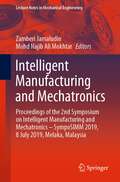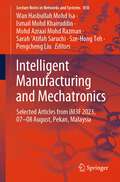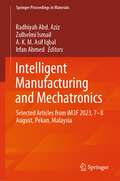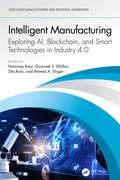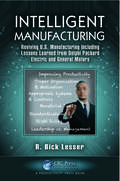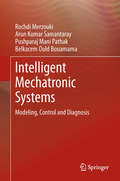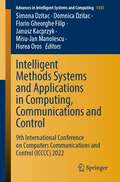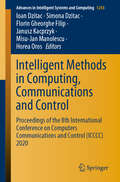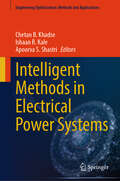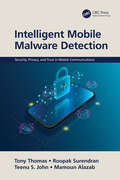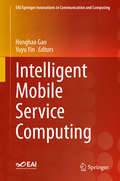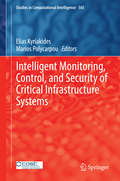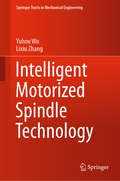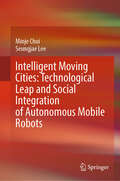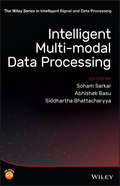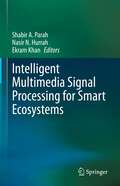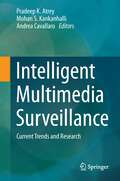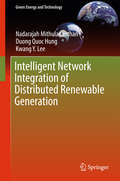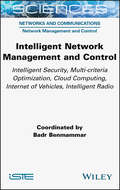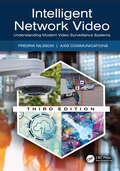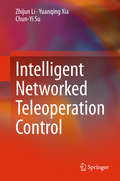- Table View
- List View
Intelligent Manufacturing and Mechatronics: Proceedings of the 2nd Symposium on Intelligent Manufacturing and Mechatronics – SympoSIMM 2019, 8 July 2019, Melaka, Malaysia (Lecture Notes in Mechanical Engineering)
by Zamberi Jamaludin Mohd Najib Ali MokhtarThis book presents the proceedings of SympoSIMM 2019, the 2nd edition of the Symposium on Intelligent Manufacturing and Mechatronics. Focusing on “Strengthening Innovations Towards Industry 4.0”, the book presents studies on the details of Industry 4.0’s current trends. Divided into five parts covering various areas of manufacturing engineering and mechatronics stream, namely, artificial intelligence, instrumentation and controls, intelligent manufacturing, modelling and simulation, and robotics., the book is a valuable resource for readers wishing to embrace the new era of Industry 4.0.
Intelligent Manufacturing and Mechatronics: Selected Articles from iM3F 2023, 07–08 August, Pekan, Malaysia (Lecture Notes in Networks and Systems #850)
by Mohd Azraai Mohd Razman Ismail Mohd Khairuddin Pengcheng Liu Wan Hasbullah Mohd Isa Sarah 'Atifah Saruchi Sze-Hong TehThis book presents parts of the iM3F 2023 proceedings from the mechatronics as well as the intelligent manufacturing tracks. It highlights recent trends and key challenges in mechatronics as well as the advent of intelligent manufacturing engineering and technology that are non-trivial in embracing Industry 4.0 as well as addressing the UN Sustainable Development Goals. The book deliberates on conventional as well as advanced solutions that are utilized in the variety of mechatronics and intelligent manufacturing-based applications. The readers are envisaged to gain an insightful view on the current trends, issues, mitigating factors as well as solutions from this book. It provides a platform that allows academics as well as other relevant stakeholders to share, discuss, and deliberate their latest research findings in the field of manufacturing, mechatronics, and materials, respectively.
Intelligent Manufacturing and Mechatronics: Selected Articles from iM3F 2023, 7–8 August, Pekan, Malaysia (Springer Proceedings in Materials #40)
by Radhiyah Abd. Aziz Zulhelmi Ismail Irfan Ahmed A. K. M. Asif IqbalThis book showcases a portion of the iM3F 2023 conference proceedings, focusing on the recent advancement in sustainable manufacturing and materials. It emphasizes recent progress, significant advancements, and challenges to the materials science and engineering community, along with the emergence of intelligent manufacturing engineering and technology while addressing the UN Sustainable Development Goals. The book discusses both traditional and advanced approaches used in various sustainable manufacturing and materials applications. Readers can expect to gain a comprehensive understanding of current trends, challenges, solutions, and mitigating factors from this publication.
Intelligent Manufacturing: Exploring AI, Blockchain, and Smart Technologies in Industry 4.0 (Intelligent Manufacturing and Industrial Engineering)
by Ahmed A. Elngar Sita Rani Navroop Kaur Gurpreet S. DhillonThe field of industrial engineering has undergone a transformation in recent years, driven by emerging technologies such as Artificial Intelligence (AI), Machine Learning, and the Internet of Things (IoT). To keep pace with these advancements, a shift toward AI-driven development has become a necessity.From case studies to national and international best practices, Intelligent Manufacturing: Exploring AI, Blockchain, and Smart Technologies in Industry 4.0 delves into the challenges of incorporating AI-driven frameworks and standards into the smart industry landscape. It explores the integration of these advanced technologies into Industry 4.0 and presents a comprehensive overview of their potential impact on industrial processes. Topics covered include security management, standard specifications, and sustainable manufacturing, highlighting the latest innovations in industrial engineering design. The book goes on to discuss the practical applications of AI-driven technologies in manufacturing, such as simulation, optimization, and sustainable development of industrial processes. A variety of real-world examples are offered, and a discussion of how these technologies are being deployed in different industries provides a clear understanding of their applications and benefits.This book is an essential guide for students, researchers, and industry professionals seeking to understand the evolving landscape of intelligent manufacturing and industrial engineering.
Intelligent Manufacturing: Reviving U.S. Manufacturing Including Lessons Learned from Delphi Packard Electric and General Motors
by R. Bick LesserIn 1791, Treasury Secretary Alexander Hamilton wrote that "not only the wealth, but the independence and security of a country, appear to be materially connected with the prosperity of manufacturers." Centuries later, U.S. manufacturing jobs continue to be outsourced at an all-too-rapid pace. Examining the current U.S. manufacturing environment, in
Intelligent Mechatronic Systems
by Rochdi Merzouki Pushparaj Mani Pathak Arun Kumar Samantaray Belkacem Ould BouamamaActing as a support resource for practitioners and professionals looking to advance their understanding of complex mechatronic systems, Intelligent Mechatronic Systems explains their design and recent developments from first principles to practical applications. Detailed descriptions of the mathematical models of complex mechatronic systems, developed from fundamental physical relationships, are built on to develop innovative solutions with particular emphasis on physical model-based control strategies. Following a concurrent engineering approach, supported by industrial case studies, and drawing on the practical experience of the authors, Intelligent Mechatronic Systems covers range of topic and includes: An explanation of a common graphical tool for integrated design and its uses from modeling and simulation to the control synthesis Introductions to key concepts such as different means of achieving fault tolerance, robust overwhelming control and force and impedance control Dedicated chapters for advanced topics such as multibody dynamics and micro-electromechanical systems, vehicle mechatronic systems, robot kinematics and dynamics, space robotics and intelligent transportation systems Detailed discussion of cooperative environments and reconfigurable systems Intelligent Mechatronic Systems provides control, electrical and mechanical engineers and researchers in industrial automation with a means to design practical, functional and safe intelligent systems.
Intelligent Methods Systems and Applications in Computing, Communications and Control: 9th International Conference on Computers Communications and Control (ICCCC) 2022 (Advances in Intelligent Systems and Computing #1435)
by Florin Gheorghe Filip Janusz Kacprzyk Simona Dzitac Misu-Jan Manolescu Horea Oros Domnica DzitacThe book contains 37 papers presented at the ninth edition of the International Conference of Computers, Communications and Control—ICCCC-2022 held in Oradea and Băile Felix, Romania. A balanced selection of both methodological and application-oriented papers has been made to reflect several recent worldwide trends and results. The book is organized into five sections: a) integrated solutions in computer-based control, b) advanced control systems integrating computers and communications, c) soft computing including fuzzy system approach, d) decision making and support systems, and e) trustworthy and green design. The study of the papers contained in the book is useful for researchers, consultants, and postgraduate students in computer science and design, applied informatics, control systems, and industrial engineering. The book is also used as auxiliary material for student-level courses such as artificial intelligence, computational intelligence, and decision support systems.
Intelligent Methods in Computing, Communications and Control: Proceedings of the 8th International Conference on Computers Communications and Control (ICCCC) 2020 (Advances in Intelligent Systems and Computing #1243)
by Florin Gheorghe Filip Janusz Kacprzyk Ioan Dzitac Simona Dzitac Misu-Jan Manolescu Horea OrosThis book presents the proceedings of the International Conference on Computers Communications and Control 2020 (ICCCC2020), covering topics such as theory for computing and communications, integrated solutions in computer-based control, computational intelligence and soft computing, decision-making and support systems.The ICCCC was founded in Romania in 2006, and its eight editions have featured respected keynote speakers and leading computer scientists from around the globe.
Intelligent Methods in Electrical Power Systems (Engineering Optimization: Methods and Applications)
by Ishaan R. Kale Apoorva S. Shastri Chetan B. KhadseThis book provides a comprehensive review of the latest developments in optimization based learning algorithms within the field of electrical engineering. It covers various power system applications including efficient power system operation, load forecasting, fault analysis, home automation and efficient smart grid management. Each application is accompanied by case studies and a literature review in self-contained chapters. The book is dedicated to study the effectiveness of intelligent methods in addressing the power system problems and its mitigation using optimization algorithms. It discusses several optimization algorithms such as random forest algorithm, metaheuristic algorithm, scaled conjugate gradient descent algorithm, artificial bee colony algorithm etc. and their usability in intelligent decision makers for the various optimization problems in electrical engineering. This timely book serves as a practical guide and reference sources for students, researchers and professionals.
Intelligent Mobile Malware Detection (Security, Privacy, and Trust in Mobile Communications)
by Tony Thomas Mamoun Alazab Roopak Surendran Teenu S. JohnThe popularity of Android mobile phones has caused more cybercriminals to create malware applications that carry out various malicious activities. The attacks, which escalated after the COVID-19 pandemic, proved there is great importance in protecting Android mobile devices from malware attacks. Intelligent Mobile Malware Detection will teach users how to develop intelligent Android malware detection mechanisms by using various graph and stochastic models. The book begins with an introduction to the Android operating system accompanied by the limitations of the state-of-the-art static malware detection mechanisms as well as a detailed presentation of a hybrid malware detection mechanism. The text then presents four different system call-based dynamic Android malware detection mechanisms using graph centrality measures, graph signal processing and graph convolutional networks. Further, the text shows how most of the Android malware can be detected by checking the presence of a unique subsequence of system calls in its system call sequence. All the malware detection mechanisms presented in the book are based on the authors' recent research. The experiments are conducted with the latest Android malware samples, and the malware samples are collected from public repositories. The source codes are also provided for easy implementation of the mechanisms. This book will be highly useful to Android malware researchers, developers, students and cyber security professionals to explore and build defense mechanisms against the ever-evolving Android malware.
Intelligent Mobile Service Computing (EAI/Springer Innovations in Communication and Computing)
by Honghao Gao Yuyu YinThis book discusses recent research and applications in intelligent service computing in mobile environments. The authors first explain how advances in artificial intelligence and big data have allowed for an array of intelligent services with complex and diverse applications. They then show how this brings new opportunities and challenges for service computing. The book, made up of contributions from academic and industry, aims to present advances in intelligent services, new algorithms and techniques in the field, foundational theory and systems, as well as practical real-life applications. Some of the topics discussed include cognition, modeling, description and verification for intelligent services; discovery, recommendation and selection for intelligent services; formal verification, testing and inspection for intelligent services; and composition and cooperation methods for intelligent services.
Intelligent Monitoring, Control, and Security of Critical Infrastructure Systems
by Elias Kyriakides Marios PolycarpouThis book describes the challenges that critical infrastructure systems face, and presents state of the art solutions to address them. How can we design intelligent systems or intelligent agents that can make appropriate real-time decisions in the management of such large-scale, complex systems? What are the primary challenges for critical infrastructure systems? The book also provides readers with the relevant information to recognize how important infrastructures are, and their role in connection with a society's economy, security and prosperity. It goes on to describe state-of-the-art solutions to address these points, including new methodologies and instrumentation tools (e. g. embedded software and intelligent algorithms) for transforming and optimizing target infrastructures. The book is the most comprehensive resource to date for professionals in both the private and public sectors, while also offering an essential guide for students and researchers in the areas of modeling and analysis of critical infrastructure systems, monitoring, control, risk/impact evaluation, fault diagnosis, fault-tolerant control, and infrastructure dependencies/interdependencies. The importance of the research presented in the book is reflected in the fact that currently, for the first time in human history, more people live in cities than in rural areas, and that, by 2050, roughly 70% of the world's total population is expected to live in cities.
Intelligent Motorized Spindle Technology (Springer Tracts in Mechanical Engineering)
by Yuhou Wu Lixiu ZhangThis book presents the latest information on the intelligent CNC machine tool spindle system, which integrates various disciplines such as mechanical engineering, control engineering, computer science and information technology. It describes a prediction method and model for temperature rise and thermal deformation in motorized spindles and proposes an intelligent stator resistance identification method to reduce the torque ripple of motorized spindles under direct torque control. Further, it discusses the on-line dynamic balance method for NC machine tool spindles. The biogeographic optimization algorithm and hybrid intelligent algorithm presented here were first applied in the field of motorized spindle performance control. In turn, the book presents extensive motorized spindle performance test data and includes detailed examples of how intelligent algorithms can be applied to motor spindle stator resistance identification, temperature field prediction and on-line dynamic balance. In summary, the book provides readers with the latest tools for designing, testing and implementing intelligent motorized spindle systems in terms of the basic theory, technological applications and future prospects, and offers a wealth of practical information for researchers in mechanical engineering, especially in the area of control systems.
Intelligent Moving Cities: Technological Leap and Social Integration of Autonomous Mobile Robots
by Seungjae Lee Minje ChoiThe book "Intelligence Moving Cities" methodically unveils the multifaceted impacts of autonomous mobile robots on urban environments. Through seven insightful chapters, readers are taken on a journey from the historical developments in robotics to cutting-edge applications that promise a more livable, safe, and efficient cityscape. From navigation systems and design tailored specifically for urban settings to their integration into daily activities, this book provides a comprehensive look at the technological advancements that are transforming our public spaces. Each chapter delves deep into critical aspects of urban autonomous robotics: the societal and technological drivers, the evolution of robotics, core technologies of navigation and mobility, design and scalability of urban-use robots, and their diverse applications ranging from public safety to personal mobility and logistics. Furthermore, it addresses the broader implications of deploying these technologies in urban settings, including urban planning, pedestrian safety, and the overall enhancement of city life. Targeted at technologists, urban planners, policymakers, and academics, "Intelligence Moving Cities" is not merely a technical recount but a profound statement on the intersection of technology, urban planning, and social integration. It offers practical examples, case studies, and forward-looking analyses, making it an indispensable resource for anyone committed to the future of urban development. Explore the transformative potential of autonomous robotics in creating more accessible, efficient, and people-oriented urban environments with "Intelligence Moving Cities." Join the movement toward revolutionizing city life, ensuring a sustainable, inclusive, and thriving future for urban landscapes
Intelligent Multi-Modal Data Processing (The Wiley Series in Intelligent Signal and Data Processing)
by Siddhartha Bhattacharyya Abhishek Basu Soham SarkarA comprehensive review of the most recent applications of intelligent multi-modal data processing Intelligent Multi-Modal Data Processing contains a review of the most recent applications of data processing. The Editors and contributors – noted experts on the topic – offer a review of the new and challenging areas of multimedia data processing as well as state-of-the-art algorithms to solve the problems in an intelligent manner. The text provides a clear understanding of the real-life implementation of different statistical theories and explains how to implement various statistical theories. Intelligent Multi-Modal Data Processing is an authoritative guide for developing innovative research ideas for interdisciplinary research practices. Designed as a practical resource, the book contains tables to compare statistical analysis results of a novel technique to that of the state-of-the-art techniques and illustrations in the form of algorithms to establish a pre-processing and/or post-processing technique for model building. The book also contains images that show the efficiency of the algorithm on standard data set. This important book: Includes an in-depth analysis of the state-of-the-art applications of signal and data processing Contains contributions from noted experts in the field Offers information on hybrid differential evolution for optimal multilevel image thresholding Presents a fuzzy decision based multi-objective evolutionary method for video summarisation Written for students of technology and management, computer scientists and professionals in information technology, Intelligent Multi-Modal Data Processing brings together in one volume the range of multi-modal data processing.
Intelligent Multimedia Signal Processing for Smart Ecosystems
by Shabir A. Parah Nasir N. Hurrah Ekram KhanA smart ecosystem is envisioned to exchange and analyze data across systems, enabling a flexible, faster, and reliable smart ecosystem for high-quality results at reduced costs and little human intervention. This book introduces many innovative approaches and provides solutions to various problems of smart ecosystems designed by employing various techniques/models based on AI, ML, Deep Learning, and the Internet of Things (IoT). The main focus is on intelligent multimedia processing and automated decision-making for various services, real-time data analysis, data security, cost-effective solutions for multimedia applications, smart information processing systems, and smart city planning to name a few. In addition, this book presents some key insights and future directions in the various areas of technology. Throughout the book, many state-of-the-art solutions concerning various applications are proposed to solve the issues and ensure the quality of services (QoS). The authors discuss the limitations of the current techniques used to design a smart ecosystem and highlight some prospective areas of research in the future. The book comprehensively discusses multimedia processing of various forms of data comprising text, images, and audio for the implementation of various solutions. The book is aimed to open many areas of research and thus would present a comprehensive reference for the design of smart ecosystems in various applications.
Intelligent Multimedia Surveillance
by Andrea Cavallaro Pradeep K. Atrey Mohan S. KankanhalliIntelligent multimedia surveillance concerns the analysis of multiple sensing inputs including video and audio streams, radio-frequency identification (RFID), and depth data. These data are processed for the automated detection and tracking of people, vehicles, and other objects. The goal is to locate moving targets, to understand their behavior, and to detect suspicious or abnormal activities for crime prevention. Despite its benefits, there is societal apprehension regarding the use of such technology, so an important challenge in this research area is to balance public safety and privacy. This edited book presents recent findings in the field of intelligent multimedia surveillance emerging from disciplines such as multimedia computing, computer vision, and artificial intelligence. It consists of nine chapters addressing intelligent video surveillance, video analysis of crowds, privacy issues in intelligent multimedia surveillance, RFID technology for localization of objects, object tracking using visual saliency information, estimating multiresolution depth using active stereo vision, and performance evaluation for video surveillance systems. The book will be of value to researchers and practitioners working on related problems in security, multimedia, and artificial intelligence.
Intelligent Music Production: A Theoretical Overview (Audio Engineering Society Presents)
by Joshua D. Reiss Brecht De Man Ryan StablesIntelligent Music Production presents the state of the art in approaches, methodologies and systems from the emerging field of automation in music mixing and mastering. This book collects the relevant works in the domain of innovation in music production, and orders them in a way that outlines the way forward: first, covering our knowledge of the music production processes; then by reviewing the methodologies in classification, data collection and perceptual evaluation; and finally by presenting recent advances on introducing intelligence in audio effects, sound engineering processes and music production interfaces. Intelligent Music Production is a comprehensive guide, providing an introductory read for beginners, as well as a crucial reference point for experienced researchers, producers, engineers and developers.
Intelligent Nanomaterials: Processes, Properties, And Applications (Advanced Material Series)
by Hisatoshi Kobayashi Ashutosh Tiwari Yogendra Kumar Mishra Anthony P. F. TurnerOverall, this book presents a detailed and comprehensive overview of the state-of-the-art development of different nanoscale intelligent materials for advanced applications. Apart from fundamental aspects of fabrication and characterization of nanomaterials, it also covers key advanced principles involved in utilization of functionalities of these nanomaterials in appropriate forms. It is very important to develop and understand the cutting-edge principles of how to utilize nanoscale intelligent features in the desired fashion. These unique nanoscopic properties can either be accessed when the nanomaterials are prepared in the appropriate form, e.g., composites, or in integrated nanodevice form for direct use as electronic sensing devices. In both cases, the nanostructure has to be appropriately prepared, carefully handled, and properly integrated into the desired application in order to efficiently access its intelligent features. These aspects are reviewed in detail in three themed sections with relevant chapters: Nanomaterials, Fabrication and Biomedical Applications; Nanomaterials for Energy, Electronics, and Biosensing; Smart Nanocomposites, Fabrication, and Applications.
Intelligent Network Integration of Distributed Renewable Generation
by Nadarajah Mithulananthan Duong Quoc Hung Kwang Y. LeeThis book introduces several simple analytical approaches to aid the seamless integration of renewable distributed generation. It focuses on the idea of intelligent integration, which involves locating and developing suitable operational characteristics of renewable distributed generation. After reviewing the options available, the best location should be chosen, an appropriately sized operation should be installed and the most suitable operational characteristics should be adopted. Presenting these simple analytical approaches, their step-by-step implementation and a number of cases studies using test distribution systems, the book clearly demonstrates the technical, economic and environmental benefits of intelligent integration.
Intelligent Network Management and Control: Intelligent Security, Multi-criteria Optimization, Cloud Computing, Internet of Vehicles, Intelligent Radio
by Badr BenmammarThe management and control of networks can no longer be envisaged without the introduction of artificial intelligence at all stages. Intelligent Network Management and Control deals with topical issues related mainly to intelligent security of computer networks, deployment of security services in SDN (software-defined networking), optimization of networks using artificial intelligence techniques and multi-criteria optimization methods for selecting networks in a heterogeneous environment. This book also focuses on selecting cloud computing services, intelligent unloading of calculations in the context of mobile cloud computing, intelligent resource management in a smart grid-cloud system for better energy efficiency, new architectures for the Internet of Vehicles (IoV), the application of artificial intelligence in cognitive radio networks and intelligent radio input to meet the on-road communication needs of autonomous vehicles.
Intelligent Network Video: Understanding Modern Video Surveillance Systems
by Fredrik Nilsson Communications AxisThe third edition traces the trajectory of video surveillance technology from its roots to its current state and into its potential future role in security and beyond. For the reader, it is an opportunity to explore what the latest technology has to offer, as well as to gain some insight into the direction that surveillance will take us in the years ahead. The revised edition of Intelligent Network Video is more comprehensive in every area than the first and second editions, printed in over 25,000 copies. There is also a new chapter on cybersecurity, as well as thoroughly revised chapters on cloud and analytics. The book takes the reader on a tour through the building blocks of intelligent network video – from imaging to network cameras and video encoders, through the IT technologies of network and storage and into video management, analytics, and system design.
Intelligent Network Video: Understanding Modern Video Surveillance Systems
by Fredrik Nilsson Communications AxisThe third edition traces the trajectory of video surveillance technology from its roots to its current state and into its potential future role in security and beyond. For the reader, it is an opportunity to explore what the latest technology has to offer, as well as to gain some insight into the direction that surveillance will take us in the years ahead.The revised edition of Intelligent Network Video is more comprehensive in every area than the first and second editions, printed in over 25,000 copies. There is also a new chapter on cybersecurity, as well as thoroughly revised chapters on cloud and analytics. The book takes the reader on a tour through the building blocks of intelligent network video – from imaging to network cameras and video encoders, through the IT technologies of network and storage and into video management, analytics, and system design.
Intelligent Network Video: Understanding Modern Video Surveillance Systems, Second Edition
by Fredrik Nilsson Communications AxisContinuing in the tradition of the bestselling first edition, this book examines networked surveillance video solutions. It provides the latest details on industry hardware, software, and networking capabilities of the latest cameras and DVRs. It addresses in full detail updated specifications on MPEG-4 and other digital video formats, resolution advantages of analog v. digital, intelligent video capabilities, frame rate control, and indoor/outdoor installations factors. New chapters include cloud computing, standards, and thermal cameras.
Intelligent Networked Teleoperation Control
by Yuanqing Xia Zhijun Li Chun-Yi SuThis book describes a unified framework for networked teleoperation systems involving multiple research fields: networked control systems for linear and nonlinear forms, bilateral teleoperation, trilateral teleoperation, multilateral teleoperation and cooperative teleoperation. It closely examines networked control as a field at the intersection of systems & control and robotics and presents a number of experimental case studies on testbeds for robotic systems, including networked haptic devices, robotic network systems and sensor network systems. The concepts and results outlined are easy to understand, even for readers fairly new to the subject. As such, the book offers a valuable reference work for researchers and engineers in the fields of systems & control and robotics.
